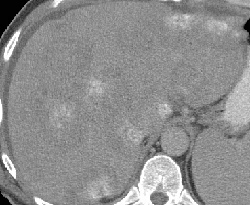
RADIOLOGY: GASTROINTESTINAL: GI: Case# 32830: CALCIFIED RECTAL CA. W/METS. This is a 62 year old male follow-up case of colon cancer with known hepatic metastases, status post surgery and recent chemotherapy. Comparison is made with prior abdomen CT done one month ago. Multiple low attenuation lesions with central calcification are present throughout the liver, most appearing increased in size. The various index lesions have increased in size as follows: 1) index lesion #1 in the anterior segment of right lobe has increased from 5.6 x 4.8 cm to 6 x 6.5 cm. 2) index lesion #2 in the medial segment of the left lobe has increased from 5.8 x 4.6 cm to 6.2 x 5.2 cm on todays exam. 3) index lesion #3 in the posterior segment of the right lobe has increased from 5.8 x 5.1 to 5.8 x 5.8 cm. Index precaval node is partially calcified and measures 2 x 2 cm. Multiple para-aortic lymph nodes are also identified essentially unchanged. No other significant adenopathy is seen. Ascites has further increased. Colorectal adenocarcinoma is one of the most common neoplasms encountered in the affluent countries of the Western world. The disease exhibits a peak age incidence in the sixth and seventh decades. It is associated with increased serum concentration of carcinoembryonic antigen (CEA). Predisposing factors for colorectal cancer include adenomatous polyps, inherited multiple polyposis syndromes, long-standing ulcerative colitis, close relatives with colon cancer, and a low fiber, high animal fat diet. Colorectal cancer varies in gross presentation according to the region of the colon involved. Carcinoma of the rectosigmoid colon usually presents in an annular manner, often producing early bowel obstruction. Carcinoma of the right colon, however, usually does not obstruct early and frequently presents with iron deficiency anemia secondary to chronic blood loss. Colon cancer spreads by direct extension due to penetration of the colon wall, lymphatic drainage to regional nodes, through the portal system to the liver, and intraperitoneal seeding. Although barium enemas and colonoscopy are the primary methods used to initially diagnose colorectal cancer, CT is an excellent procedure for the detection of recurrence. CT findings of colon cancer include focal lobulated soft tissue mass in the colon, localized thickening of greater than 5 mm of the bowel wall, irregular lumen surface, extension of linear soft tissue densities or discrete mass into pericolic fat or adjacent organs, regional adenopathy, and liver metastases. Soft tissue masses visualized within the peritoneal cavity may signify metastases or recurrence of the cancer. Calcification in the primary tumor can be seen with mucinous adenocarcinoma.